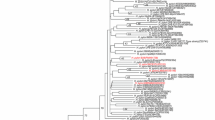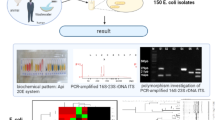Abstract
Phenotypic identification of non-pylori Helicobacter species has always been problematic and time-consuming in comparison with many other bacteria. We developed a rapid two-step identification assay based on PCR–restriction fragment length polymorphism (PCR–RFLP) analysis of the 23S rRNA gene for differentiating between non-pylori Helicobacter species. A new genus-specific primer pair based on all available complete and partial 23S rRNA sequences of Helicobacter species was designed. In silico restriction analysis of variable regions of the 23S rRNA gene suggested SmaI and HindIII endonucleases would provide a good level of differentiation. Analysis of the obtained 23S rRNA RFLP patterns divided all Helicobacter study strains into three species groups (groups A–C) and 12 unique restriction patterns. Wolinella succinogenes also gave a unique pattern. Our proposed PCR–RFLP method was found to be as a valuable tool for routine identification of non-pylori Helicobacter species from human or animal samples.


Similar content being viewed by others
References
Abd-El-Haleem D, Layton AC, Sayler GS (2002) Long PCR-amplified rDNA for PCR–RFLP- and Rep-PCR-based approaches to recognize closely related microbial species. J Microbiol Methods 49:315–319
Al-Soud WA, Bennedsen M, On SL, Ouis IS, Vandamme P, Nilsson HO, Ljungh A, Wadström T (2003) Assessment of PCR-DGGE for the identification of diverse Helicobacter species, and application to faecal samples from zoo animals to determine Helicobacter prevalence. J Med Microbiol 52:765–771
Atherton JC, Blaser MJ (2009) Coadaptation of Helicobacter pylori and humans: ancient history, modern implications. J Clin Invest 119:2475–2487
Baar C, Ep**er M, Raddatz G, Simon J, Lanz C, Klimmek O, Nandakumar R, Gross R, Rosinus A, Keller H, Jagtap P, Linke B, Meyer F, Lederer H, Schuster SC (2003) Complete genome sequence and analysis of Wolinella succinogenes. Proc Natl Acad Sci 100:11690–11695
Baele M, Van den Bulck K, Decostere A, Vandamme P, Hänninen ML, Ducatelle R, Haesebrouck F (2004) Multiplex PCR assay for differentiation of Helicobacter felis, H. bizzozeronii, and H. salomonis. J Clin Microbiol 42:1115–1122
Baele M, Decostere A, Vandamme P, Ceelen L, Hellemans A, Mast J, Chiers K, Ducatelle R, Haesebrouck F (2008a) Isolation and characterization of Helicobacter suis sp. nov. from pig stomachs. Int J Syst Evol Microbiol 58:1350–1358
Baele M, Decostere A, Vandamme P, Van den Bulck K, Gruntar I, Mehle J, Mast J, Ducatelle R, Haesebrouck F (2008b) Helicobacter baculiformis sp. nov., isolated from feline stomach mucosa. Int J Syst Evol Microbiol 58:357–364
Baele M, Pasmans F, Flahou B, Chiers K, Ducatelle R, Haesebrouck F (2009) Non-Helicobacter pylori helicobacters detected in the stomach of humans comprise several naturally occurring Helicobacter species in animals. FEMS Immunol Med Microbiol 55:306–313
Bohr UR, Primus A, Zagoura A, Glasbrenner B, Wex T, Malfertheiner P (2002) A group-specific PCR assay for the detection of Helicobacteriaceae in human gut. Helicobacter 7:378–383
Brondson MA, Goodwin CS, Sly LI, Chilvers T, Schoenknecht FD (1991) Helicobacter nemestrinae sp. nov., a spiral bacterium found in the stomach of a pigtailed macaque (Macaca nemestrina). Int J Syst Bacteriol 41:148–153
Chen YC, Eisner JD, Kattar MM, Rassoulian-Barret SL, LaFe K, Yarfitz SL, Limaye AP, Cookson BT (2000) Identification of medically important yeasts using PCR-based detection of DNA sequence polymorphisms in the internal transcribed spacer 2 region of the rRNA genes. J Clin Microbiol 38:2302–2310
Clarridge JE III (2004) Impact of 16S rRNA gene sequence analysis for identification of bacteria on clinical microbiology and infectious diseases. Clin Microbiol Rev 17:840–862
Craven M, Recordati C, Gualdi V, Pengo G, Luini M, Scanziani E, Simpson KW (2011) Evaluation of the Helicobacteraceae in the oral cavity of dogs. Am J Vet Res 72:1476–1481
De Bruyne K, Slabbinck B, Waegeman W, Vauterin P, De Baets B, Vandamme P (2011) Bacterial species identification from MALDI-TOF mass spectra through data analysis and machine learning. Syst Appl Microbiol 34:20–29
De Groote D, van Doorn LJ, Ducatelle R, Verschuuren A, Haesebrouck F, Quint WG, Jalava K, Vandamme P (1999) “Candidatus Helicobacter suis”, a gastric Helicobacter from pigs, and its phylogenetic relatedness to other gastrospirilla. Int J Syst Bacteriol 49:1769–1777
De Groote D, Haesebrouck F, van Doorn LJ, Vandamme P, Ducatelle R (2001) Evaluation of a group-specific 16S ribosomal DNA-based PCR for detection of Helicobacter bizzozeronii, Helicobacter felis, and Helicobacter salomonis in fresh and paraffin-embedded gastric biopsy specimens. J Clin Microbiol 39:1197–1199
De Rijk P, Neefs JM, van de Peer Y, De Wachter R (1992) Compilation of small ribosomal subunit RNA sequences. Nucleic Acids Res 20:2075–2089
Dewhirst FE, Fox JG, Mendes EN, Paster BJ, Gates CE, Kirkbride CA, Eaton KA (2000) ‘Flexispira rappini’ strains represent at least 10 Helicobacter taxa. Int J Syst Evol Microbiol 50:1781–1787
Elliott DR, Wilson M, Buckley CM, Spratt DA (2005) Cultivable oral microbiota of domestic dogs. J Clin Microbiol 43:5470–5476
Foley JE, Marks SL, Munson L, Melli A, Dewhirst FE, Yu S, Shen Z, Fox JG (1999) Isolation of Helicobacter canis from a colony of Bengal cats with endemic diarrhea. J Clin Microbiol 37:3271–3275
Fox JG (2002) The non-H pylori helicobacters: their expanding role in gastrointestinal and systemic diseases. Gut 50:273–283
Fox JG, Dewhirst FE, Shen Z, Feng Y, Taylor NS, Paster BJ, Ericson RL, Lau CN, Correa P, Araya JC, Roa I (1998) Hepatic Helicobacter species identified in bile and gallbladder tissue from Chileans with chronic cholecystitis. Gastroenterology 114:755–763
Franklin CL, Beckwith CS, Livingston RS, Riley LK, Gibson SV, Besch-Williford CL, Hook RR Jr (1996) Isolation of a novel Helicobacter species, Helicobacter cholecystus sp. nov., from the gallbladders of Syrian hamsters with cholangiofibrosis and centrilobular pancreatitis. J Clin Microbiol 34:2952–2958
Gurtler V, Stanisich VA (1996) New approaches to ty** and identification of bacteria using the 16S–23S rDNA spacer region. Microbiology 142:3–16
Gurtler V, Wilson VA, Mayall BC (1991) Classification of medically important clostridia using restriction endonuclesase site differences of PCR-amplified 16S rDNA. J Gen Microbiol 137:2673–2679
Haesebrouck F, Pasmans F, Flahou B, Chiers K, Baele M, Meyns T, Decostere A, Ducatelle R (2009) Gastric helicobacters in domestic animals and nonhuman primates and their significance for human health. Clin Microbiol Rev 22:202–223
Haesebrouck F, Pasmans F, Flahou B, Smet A, Vandamme P, Ducatelle R (2011) Non-Helicobacter pylori Helicobacter species in the human gastric mucosa: a proposal to introduce the terms H. heilmannii sensu lato and sensu stricto. Helicobacter 16:339–340
Hannula M, Hänninen ML (2007) Phylogenetic analysis of Helicobacter species based on partial gyrB gene sequences. Int J Syst Evol Microbiol 57:444–449
Hunt DE, Klepac-Ceraj V, Acinas SG, Gautier C, Bertilsson S, Polz MF (2006) Evaluation of 23S rRNA PCR primers for use in phylogenetic studies of bacterial diversity. Appl Environ Microbiol 72:2221–2225
Hurtado A, Owen RJ (1997a) A molecular scheme based on 23S rRNA gene polymorphisms for rapid identification of Campylobacter and Arcobacter species. J Clin Microbiol 35:2401–2404
Hurtado A, Owen RJ (1997b) A rapid identification scheme for Helicobacter pylori and other species of Helicobacter based on 23S rRNA gene polymorphisms. Syst Appl Microbiol 20:222–231
Hwang CY, Han HR, Youn HY (2002) Prevalence and clinical characterization of gastric Helicobacter species infection of dogs and cats in Korea. J Vet Sci 3:123–133
Kusters JG, van Vliet AH, Kuipers EJ (2006) Pathogenesis of Helicobacter pylori infection. Clin Microbiol Rev 19:449–490
Ludwig W, Schleifer KH (1994) Bacterial phylogeny based on 16S and 23S rRNA sequence analysis. FEMS Microbiol Rev 15:155–173
Man SM, Kaakoush NO, Octavia S, Mitchell H (2010) The internal transcribed spacer region, a new tool for use in species differentiation and delineation of systematic relationships within the Campylobacter genus. Appl Environ Microbiol 76:3071–3081
Marshall BJ, Warren JR (1984) Unidentified curved bacilli in the stomach of patients with gastritis and peptic ulceration. Lancet 1:1311–1315
Marshall SM, Melito PL, Woodward DL, Johnson WM, Rodgers FG, Mulvey MR (1999) Rapid identification of Campylobacter, Arcobacter, and Helicobacter isolates by PCR–restriction fragment length polymorphism analysis of the 16S rRNA gene. J Clin Microbiol 37:4158–4160
Mikkonen TP, Kärenlampi RI, Hänninen ML (2004) Phylogenetic analysis of gastric and enterohepatic Helicobacter species based on partial HSP60 gene sequences. Int J Syst Evol Microbiol 54:753–758
Moyaert H, Decostere A, Vandamme P, Debruyne L, Mast J, Baele M, Ceelen L, Ducatelle R, Haesebrouck F (2007) Helicobacter equorum sp. nov., a urease-negative Helicobacter species isolated from horse faeces. Int J Syst Evol Microbiol 57:213–218
Moyaert H, Pasmans F, Ducatelle R, Haesebrouck F, Baele M (2008) Evaluation of 16S rRNA gene-based PCR assays for genus-level identification of Helicobacter species. J Clin Microbiol 46:1867–1869
Neiger R, Dieterich C, Burnens A, Waldvogel A, Corthesy-Theulaz I, Halter F, Lauterburg B, Schmassmann A (1998) Detection and prevalence of Helicobacter infection in pet cats. J Clin Microbiol 36:634–637
Nilsson HO, Taneera J, Castedal M, Glatz E, Olsson R, Wadström T (2000) Identification of Helicobacter pylori and other Helicobacter species by PCR, hybridization, and partial DNA sequencing in human liver samples from patients with primary sclerosing cholangitis or primary biliary cirrhosis. J Clin Microbiol 38:1072–1076
O’Rourke JL, Solnick JV, Neilan BA, Seidel K, Hayter R, Hansen LM, Lee A (2004) Description of “Candidatus Helicobacter heilmannii” based on DNA sequence analysis of 16S rRNA and urease genes. Int J Syst Evol Microbiol 54:2203–2211
On SL (1996) Identification methods for campylobacters, helicobacters, and related organisms. Clin Microbiol Rev 9:405–422
Pei A, Nossa CW, Chokshi P, Blaser MJ, Yang L, Rosmarin DM, Pei Z (2009) Diversity of 23S rRNA genes within individual prokaryotic genomes. PLoS ONE 4:e5437
Polk DB, Peek RM Jr (2010) Helicobacter pylori: gastric cancer and beyond. Nat Rev Cancer 10:403–414
Shen Z, Feng Y, Fox JG (2000) Identification of enterohepatic Helicobacter species by restriction fragment-length polymorphism analysis of the 16S rRNA gene. Helicobacter 5:121–128
Smet A, Flahou B, D’Herde K, Vandamme P, Cleenwerck I, Ducatelle R, Pasmans F, Haesebrouck F (2012) Helicobacter heilmannii sp. nov., isolated from feline gastric mucosa. Int J Syst Evol Microbiol 69:299–306
Solnick JV, Schauer DB (2001) Emergence of diverse Helicobacter species in the pathogenesis of gastric and enterohepatic diseases. Clin Microbiol Rev 14:59–97
Sudagidan M, Yenidunya AF, Gunes H (2005) Identification of staphylococci by 16S internal transcribed spacer rRNA gene restriction fragment length polymorphism. J Med Microbiol 54:823–826
Suerbaum S, Kraft C, Dewhirst FE, Fox JG (2002) Helicobacter nemestrinae ATCC 49396T is a strain of Helicobacter pylori (Marshall et al. 1985) Goodwin et al. 1989, and Helicobacter nemestrinae Bronsdon et al. 1991 is therefore a junior heterotypic synonym of Helicobacter pylori. Int J Syst Evol Microbiol 52:437–439
Van den Bulck K, Decostere A, Baele M, Driessen A, Debongnie JC, Burette A, Stolte M, Ducatelle R, Haesebrouck F (2005) Identification of non-Helicobacter pylori spiral organisms in gastric samples from humans, dogs and cats. J Clin Microbiol 43:2256–2260
Van den Bulck K, Decostere A, Baele M, Vandamme P, Mast J, Ducatelle R, Haesebrouck F (2006) Helicobacter cynogastricus sp. nov., isolated from the canine gastric mucosa. Int J Syst Evol Microbiol 56:1559–1564
Vandamme P, Falsen E, Rossau R, Hoste B, Segers P, Tytgat R, De Ley J (1991) Revision of Campylobacter, Helicobacter, and Wolinella taxonomy: emendation of generic descriptions and proposal of Arcobacter gen. nov. Int J Syst Bacteriol 41:88–103
Vandamme P, Harrington CS, Jalava K, On SL (2000) Misidentifying helicobacters: the Helicobacter cinaedi example. J Clin Microbiol 38:2261–2266
Yavuz E, Gunes H, Bulut C, Harsa S, Yenidunya AF (2004) RFLP of 16S-ITS rDNA region to differentiate Lactobacilli at species level. World J Microbiol Biotechnol 20:535–537
Zeng YH, Koblizek M, Li YX, Liu YP, Feng FY, Ji JD, Jian JC, Wu ZH (2013) Long PCR–RFLP of 16S-ITS-23S rRNA genes: a high-resolution molecular tool for bacterial genoty**. J Appl Microbiol 114:433–447
Acknowledgments
This work was financially supported by a research grant (Code: 574) from Gastroenterology and Liver Diseases Research Center, Shahid Beheshti University of Medical Sciences, Tehran, Iran.
Conflict of interest
The authors have no conflict of interest to declare.
Author information
Authors and Affiliations
Corresponding author
Rights and permissions
About this article
Cite this article
Yadegar, A., Alebouyeh, M., Lawson, A.J. et al. Differentiation of non-pylori Helicobacter species based on PCR–restriction fragment length polymorphism of the 23S rRNA gene. World J Microbiol Biotechnol 30, 1909–1917 (2014). https://doi.org/10.1007/s11274-014-1615-2
Received:
Accepted:
Published:
Issue Date:
DOI: https://doi.org/10.1007/s11274-014-1615-2




